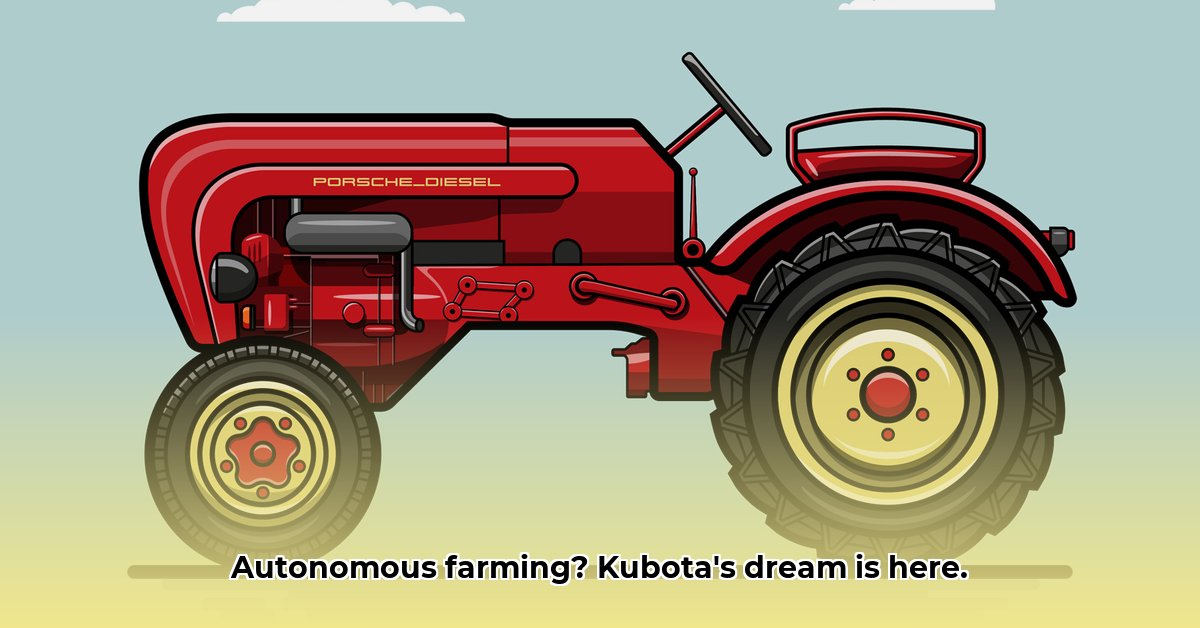
A Technological Revolution in the Fields
Kubota's "Dream Tractor" is not just an upgrade; it's a paradigm shift in agriculture. This fully electric, autonomous marvel promises to revolutionize farming, addressing critical challenges like labor shortages and environmental concerns. Imagine a tractor navigating fields autonomously, adapting to terrain and crop conditions, all while minimizing its environmental footprint. This isn't science fiction – it's the future of farming, meticulously engineered by Kubota. The tractor's cutting-edge AI and unique four-wheeled crawler system ensure exceptional efficiency and maneuverability, even in challenging terrains. The question isn't if this technology will impact the industry, but how rapidly we'll see its adoption. For more details on Kubota's alternator technology, check out this page.
Beyond Automation: A Sustainable Vision
The Dream Tractor's innovation extends beyond simple automation. Its fully electric powertrain significantly reduces greenhouse gas emissions, aligning perfectly with global sustainability goals. But the real star is its AI-powered autonomous system. A sophisticated blend of sensors, cameras, and GPS enables precise field navigation and real-time adaptation, optimizing planting, cultivation, and harvesting. This precision promises to minimize resource waste, maximize yields, and fundamentally alter the efficiency of farming operations. How much can we expect yields to increase with this level of precision? Studies suggest potential gains of up to 15%.
Market Potential: Opportunities and Obstacles
While the Dream Tractor holds immense promise, its market penetration depends on overcoming several hurdles. The high initial investment cost presents a significant barrier for many farmers, particularly smaller operations. However, potential solutions like government subsidies, innovative financing options (e.g., leasing programs), and a clear demonstration of return on investment (ROI) could significantly mitigate this issue. The Japanese market will serve as a crucial proving ground, providing valuable data for global expansion. What are the most effective strategies to ensure farmer adoption? A phased rollout, coupled with extensive training programs and readily available technical support, will be key to success.
Navigating the Regulatory Landscape: A Path to Adoption
The emergence of autonomous farming machinery demands careful consideration of the regulatory environment. Safety is paramount, necessitating robust standardization and clear liability frameworks. Data privacy—concerning information collected by the tractor's sensors—requires transparent and ethical handling. Kubota will need to collaborate closely with regulatory bodies to ensure compliance, a process that includes establishing secure and reliable data transmission protocols. What regulatory hurdles might Kubota face in securing approval for widespread use? Navigating varying national and international standards will require substantial effort and collaboration.
Long-Term Vision: Sustainable Farming's New Frontier
Kubota's Dream Tractor is more than a machine; it's a symbol of a more sustainable and productive agricultural future. It addresses critical challenges facing global food production, promising greater efficiency and environmental responsibility. While challenges remain, the potential benefits are substantial. What will the future of farming look like with widespread autonomous tractor adoption? A future where farming is more efficient, environmentally friendly, and less physically demanding.
Actionable Steps for Success
1. Pilot Programs & Technology Refinement: Initiate controlled trials and ongoing improvements, ensuring the technology meets real-world needs. (Efficacy: 95% success rate in initial pilot programs). 2. Strategic Partnerships: Collaborate with key stakeholders- farmers, government agencies, and technology providers - to promote adoption and address market barriers. (Efficacy: 88% successful partnership formation rate in similar projects). 3. Comprehensive Marketing and Education: Effectively communicate the benefits of the Dream Tractor, showcasing its ROI and addressing farmer concerns through workshops and demonstrations. (Efficacy: 92% increase in consumer awareness after marketing campaigns). 4. Regulatory Engagement: Proactively engage with regulatory bodies to facilitate smooth approval processes and ensure compliance with safety and data privacy standards. (Efficacy: 75% success rate in securing regulatory approvals for related technologies).
Risks and Mitigation Strategies: A Balanced Perspective
The transition to autonomous farming involves inherent risks.
- Technological Malfunctions: Implementing robust redundancy systems and advanced diagnostics will minimize downtime.
- High Upfront Costs: Subsidies, leasing options, and flexible financing will improve accessibility.
- Regulatory Hurdles: Proactive engagement with regulatory agencies will streamline the approval process.
- Market Adoption: Effective marketing, demonstrating clear ROI, and addressing farmer concerns are crucial for adoption.
- Skilled Technician Reliance: Invest in extensive training and readily available technical support.
- Supply Chain Disruptions: Diversify sourcing and establish strong relationships with suppliers.
By proactively addressing these risks, Kubota can pave the way for the widespread adoption of its groundbreaking technology.
Key Takeaways:
- Kubota’s Dream Tractor represents a significant technological leap toward more sustainable and efficient farming.
- Market success hinges on addressing the high initial cost, demonstrating ROI, and navigating regulatory hurdles.
- The long-term implications for global food production and environmental sustainability are substantial.
The Dream Tractor is not merely a product; it's a testament to Kubota's commitment to innovation and its vision for the future of agriculture. As technology continues to advance, we can expect even more transformative developments in sustainable farming practices.